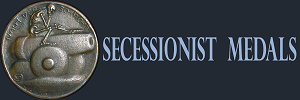51
Margit Valsassina / "Archaic warrior / St Christopher
« Last post by Rabenauge on April 11, 2020, 03:19:23 AM »Margit Valsassina*. 1917.
"Archaic warrior" (obverse) / "St Christopher" (reverse). Hexagonal cast iron, blackened, 69.7 x 60.0 mm, 56.43 g, delicately oxidized patina. Vorzüglich (extremely fine), slight abrasions to blackening.
Obverse: On raised ground-line exergue, archaic Greek warrior in corselet and crested helmet striding to left alongside bridled horse; in left hand diagonal lance and round shield with ship motif; right hand trailing behind, dragging crocodile (dragon?) skin; two-line inscription WENN UNS NICHTS MEHR ÜBRIG BLIEB / SO BLIEB UNS DOCH EIN SCHWERT (if nothing more remained to us / there yet remained a sword) in exergue; poet's name E. v. —— GEIBEL beneath inscription, left and right, respectively; year date 19 [Iron Cross] 17 at lowest point of hexagon; artist's monogram interlaced MV lower left above exergue; thin raised rim.
Reverse: Above raised ground-line exergue, robed St Christopher with staff exits river on stepping stones to right, frame bent under the weight of haloed Christ Child on shoulders pointing right; diagonally descending line, left to right, across background; two-line inscription WENN DIE NOT NICHT EISEN BRICHT / DAS EISEN BRICHT DIE NOT (if distress breaks not the iron / the iron shall break distress) in exergue; poet's name E. v. —— GEIBEL beneath inscription, left and right, respectively; year date 19 [Iron Cross] 17 at lowest point of hexagon; artist's monogram interlaced MV lower right on stone above exergue; thin raised rim.
Margit Valsassina*. 1917. "Archaic warrior". Hexagonal single-sided cast iron, blackened, 111.37 x 90.77 mm, 183.27 g. Integral suspension hanger at top point of hexagon. Vorzüglich (extremely fine).
Image, inscriptions, and signature as above description obverse, but upper edge with double-stepped raised border rim, outer and wider band contiguous with raised exergue. (There also exists a single-sided companion piece of St Christopher image, also with hanger.)
Cf: Wipplinger, Eva. 1992. Medaillenkünstlerinnen in Deutschland. Staatliche Galerie Moritzburg Halle, p. 128 (ancient warrior; single-sided example with integral hanger).
Cf: Klose, Dietrich O. A. 2016. Europas Verderben 1914 1918: Deutsche und österreichische Medaillen auf den Ersten Weltkrieg, p. 62: 4.6 (two single-sided plaquettes with integral hangers treated under same entry).
*Pseudonym of sculptress Margarethe Klementine Maria von Österreich, Fürstin (Princess) v. Thurn und Taxis (1870 - 1955.
Inscriptions drawn from a verse of "Kriegslied" (war song) by Emanuel von Geibel (1815 - 1884): Und wenn uns nichts mehr übrig blieb, / So blieb uns doch ein Schwert, / Das zorngemut mit scharfem Hieb / Dem Trutz des Fremdlings wehrt; / So blieb die Schlacht als letzt' Gericht / Auf Leben und auf Tod; / Und wenn die Not nicht Eisen bricht, / Das Eisen bricht die Not. (And if not more remained to us, / There yet remained a sword, / That with sharp and wrathful blow / Resists the malice of the foe; / So battle stayed as final judge / Over life and death; / And if distress then breaks not iron / The iron shall break distress - my (un-poetic) translation).

 Recent Posts
Recent Posts